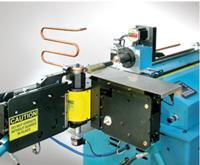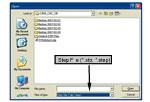- FMA
- The Fabricator
- FABTECH
- Canadian Metalworking
Categories
- Additive Manufacturing
- Aluminum Welding
- Arc Welding
- Assembly and Joining
- Automation and Robotics
- Bending and Forming
- Consumables
- Cutting and Weld Prep
- Electric Vehicles
- En Español
- Finishing
- Hydroforming
- Laser Cutting
- Laser Welding
- Machining
- Manufacturing Software
- Materials Handling
- Metals/Materials
- Oxyfuel Cutting
- Plasma Cutting
- Power Tools
- Punching and Other Holemaking
- Roll Forming
- Safety
- Sawing
- Shearing
- Shop Management
- Testing and Measuring
- Tube and Pipe Fabrication
- Tube and Pipe Production
- Waterjet Cutting
Industry Directory
Webcasts
Podcasts
FAB 40
Advertise
Subscribe
Account Login
Search
Serpentine bending in production
Making 180-degree bends quickly, efficiently
- By George Winton
- November 25, 2008
- Article
- Tube and Pipe Fabrication
You might not see serpentine bends often, but they are used more commonly than you probably realize. Their main purpose is to transfer heat. A tube bent into a serpentine shape, successive 180-degree bends, allows an original equipment manufacturer (OEM) to fabricate a product that extracts heat from one environment and transports that heat into another (see Figure 1). For example, in a common household refrigerator, energy in the form of heat is contained in the products that you want to keep cool. The refrigeration system's goal is to extract the energy from those products, and a serpentine-shaped tube is an efficient way to do this.
A serpentine profile maximizes the amount of surface area (and thus refrigerant) used for heat transfer in a limited amount of space. Because a serpentine profile is usually one continuous bent tube, by default the number of connections is limited to two, one at each end, thus reducing the OEM's warranty costs.
What are the options for making a serpentine profile? At one extreme are manual benders; at the other are CNC benders. Understanding serpentine bending—the raw material input, the bending process, the finished part output, and part consistency and quality parameters—can help you find the right equipment for your application.
Before Bending
When considering how to make a serpentine bend, it is necessary to keep two main factors in mind. The first concerns the bender's capabilities; the second concerns the finished part.
First, because a serpentine shape is a series of 180-degree bends, the design and construction of the bender are important considerations. The bender must have sufficient clearance in the die area to make the bend without interference between the bender and the bent tube. Every bender, even a machine designed specifically for serpentine bending, has limitations. A hand bender must have the necessary clearance around the bend tooling. On a bending machine, the bending die, clamp die, and pressure die work together. To make a serpentine bend, especially one with a tight radius, the bender must be able to make successive bends without interference among the bent tube, the pressure die, and the clamp die (see Figure 2).
A second factor is bend consistency. Consistent bends in a flat plane provide the most efficient refrigerant flow and therefore the optimal heat transfer. This is critical to OEMs that manufacture refrigeration and cooling systems, so it follows that fabricators can use consistency as a competitive advantage when manufacturing components for this industry. Consistency is affected by nearly every equipment aspect: bender selection, bending process, and the material handling system.
Manual Bending
Quite often in the development process of a new configuration, fabricators use hand benders to produce the necessary serpentine shape. With a drawing in hand, the operator takes a scale, marks the tube where the bends will start, and starts bending. The goal is to deliver for testing a tube that looks like the drawing. After the prototype is tested and accepted, the production models are expected to have the same dimensions as the prototype. Often the production process becomes a little easier as the operator refines the means of laying out and making the bends.
A significant advantage of hand bending is that the initial equipment investment is modest. A disadvantage is that the quality varies. If the operator's focus fades, the quality suffers.
CNC Bending
While manual bending can produce acceptable bends, CNC bending can take serpentine bending to a higher quality level. First, a CNC process provides better repeatability than a manual process does, resulting in better product consistency. Second, coupled with the right material handling system, a CNC system can produce a flatter serpentine product than a manual system can.
Software. State-of-the-art software can allow an engineering department to send a CAD-generated STEP file of the serpentine profile directly to the bender (seeFigure 3). This saves time in programming by eliminating the need to key in the data points. A programming option that tells the bender that the tube is to be bent to a serpentine profile likewise simplifies the process (see Figure 4).

Figure 1Click image to view larger A serpentine profile comprises several back-to-back bends, also known as return bends.
Sufficient Clearance Revisited. A standard rotary bender doesn't have sufficient clearance behind the clamp and pressure dies for serpentine bending. However, this doesn't always rule out serpentine bending. Depending on the available clearance, it is possible to make a bend, rotate the plane of bend 180 degrees, then make the next bend, and so on.
As the distance between bends increases, it becomes more important to make the bends without rotating the tube about the plane of bend. A bender capable of both clockwise and counterclockwise (CW/CCW) bending is well-suited to this application. In addition to eliminating the need to rotate the plane of bend, a CW/CCW bender creates a flatter bend profile (see Figure 5).
A serpentine bender is designed and built to provide the necessary clearances for all aspects of the bending process. This includes a carriage that presents the tube to the bend zone. The bending motion and the carriage feeding motion cannot interfere with each other; the serpentine coil, which can be up to 48 inches long, must clear the carriage as the bender approaches 180 degrees. Without this clearance, the bender cannot achieve the intended profile.
In a serpentine profile, the bender's controller may have to compensate for certain variables to provide the necessary clearance. Some CNCs are preprogrammed with serpentine functions to reduce the operator's programming burden.
Material Handling. Making informed choices about how the tube gets off the spool and to the bend zone can boost productivity. A payoff supporting a bulk spool of tubing can add value to a production operation. Depending on the speed at which the bender pulls the tubing off the spool, the payoff may not have to be powered. Hitch feeding the tube into the bend zone often is better than trying to end-chuck the tube into the bend zone. Using hitch feeding makes the length of the bending machine less important.
On the outfeed side, two choices are a static table and a rotating table (seeFigure 6). A static table surrounds the bending machine. As the bender forms the serpentine profile, the tubing moves back and forth on the table. The disadvantage with a static table is friction. The drag between the profile and table wastes some of the bending head's power. A rotating support table is synchronized to the bending head. As the bending head rotates, so does the support table.
The final step is cutting the finished profile from the remainder of the coil. An inline cutoff, which can be integrated with the CNC, simplifies this task.
Designing for Production
A few guidelines can help make a serpentine bending project a success. First, compare the serpentine profile's shape with your bender's die clearances. Does the bender have enough clearance to form that part, or will it have trouble with interference?
Second, if possible, make the centerline radius (CLR) at least twice the tube's OD. For example, if the project requires 3⁄8-in. tubing, use a CLR at least 3⁄4 in. The need for a mandrel increases as the CLR decreases, and using a mandrel isn't possible when bending material spooled from a coil.
Third, design the tube so that the operator will not have to support the tube during the bending process. It is common that a serpentine profile ends with a 90-degree bend that contacts the machine or the finished profile itself. In such a scenario, the operator must manipulate the tube during the bending process, which is a safety hazard.
Last, if it looks impossible, don't despair. Some projects involve one or two bends that look too difficult to make in sequence. You don't have to complete every bend in order. If a bend doesn't seem to fit into the process, you have options. Try bending it partway and finishing it later, or skipping it altogether during the first pass and making it in a secondary operation.
About the Author

George Winton
3644 Burnette Road
Suwanee, GA 30024
888-321-1499
About the Publication
Related Companies
subscribe now

The Tube and Pipe Journal became the first magazine dedicated to serving the metal tube and pipe industry in 1990. Today, it remains the only North American publication devoted to this industry, and it has become the most trusted source of information for tube and pipe professionals.
start your free subscription- Stay connected from anywhere

Easily access valuable industry resources now with full access to the digital edition of The Fabricator.

Easily access valuable industry resources now with full access to the digital edition of The Welder.

Easily access valuable industry resources now with full access to the digital edition of The Tube and Pipe Journal.
- Podcasting
- Podcast:
- The Fabricator Podcast
- Published:
- 04/16/2024
- Running Time:
- 63:29
In this episode of The Fabricator Podcast, Caleb Chamberlain, co-founder and CEO of OSH Cut, discusses his company’s...
- Trending Articles
Team Industries names director of advanced technology and manufacturing

Orbital tube welding webinar to be held April 23

Chain hoist offers 60-ft. remote control range

Push-feeding saw station cuts nonferrous metals

Corrosion-inhibiting coating can be peeled off after use

- Industry Events
16th Annual Safety Conference
- April 30 - May 1, 2024
- Elgin,
Pipe and Tube Conference
- May 21 - 22, 2024
- Omaha, NE
World-Class Roll Forming Workshop
- June 5 - 6, 2024
- Louisville, KY
Advanced Laser Application Workshop
- June 25 - 27, 2024
- Novi, MI




























